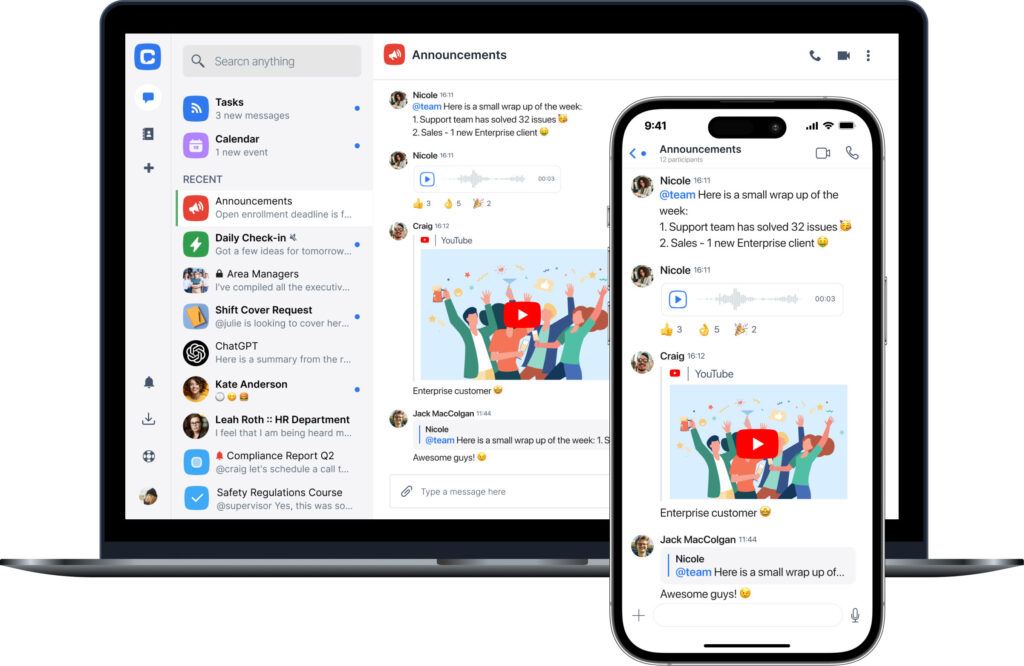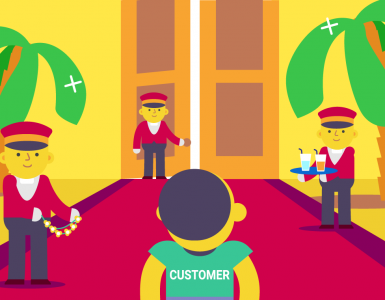There is so much more that goes into a marketing team than just content creation. These teams daily help drive strategy, coordinate campaigns, and ensure that all departments are speaking the same language. Too often, however, the collaboration feels like a game of telephone: messages get lost, feedback bounces around tools, and tasks fall through the cracks. Ring a bell?
Here, marketing collaboration software comes in as a savior. It is not just communication in check but a place that makes everything regarding marketing happen within one location-from brainstorming ideas to tracking projects and keeping everyone on the same track and efficiently.
However, picking the right software can be a daunting task. Especially when are just so many of them on the market. Some of them specialize in task management. Others shine in communication or file sharing. So, how do you pick the one that fits your team’s needs?
By the end of this post, you’ll know exactly how to choose the right marketing collaboration software. Let’s explore how these tools can reshape your team’s workflow.
What is marketing collaboration software?
Marketing collaboration software is far more than just a tool; it’s the online heartbeat of an integrated marketing team. At its very basic level, it’s where creativity, strategy, and execution converge perfectly, allowing teams to collaborate from anywhere, anytime. From concept to planning content by channel to overseeing the status of a big campaign, these systems automate each part of the process.
What sets marketing collaboration software apart is that it unites scattered functions—communication, project management, file sharing, and even analytics—within one setting. Imagine a collaborative virtual whiteboard for live brainstorming, where every member’s thoughts are projected and can be discussed in the moment. No more excavating feedback from emails or managing several versions of documents. The software ensures that all things, from creative concepts to finished content, are housed and accessible in a single source.
Beyond basic task management, these platforms ensure teams stay synchronized across all stages of a campaign. Their customizable workflows, live updates, and automated reminders free your team to focus more on strategy and creativity, not administrative tasks. Whether organizing a content calendar or navigating the approval process, these tools help align everyone quickly.
In a fast-moving marketing world, these platforms provide speed without sacrificing quality. They allow teams to collaborate effortlessly and quickly adapt to new challenges, promoting an agile, responsive marketing approach.
How marketing collaboration software can improve team creativity
Creativity thrives on connection. Marketing collaboration software makes teamwork seamless and communication centralized, bridging the gaps that more often than not get in the way of innovative thinking. It is not just a place to organize tasks or track deadlines; it’s where your team’s best ideas come alive.
Think about it: when was the last time a brilliant idea emerged from a disorganized email thread or a scattered bunch of notes? Probably never. Creativity needs clarity. Collaboration tools create that space. They bring ideas, feedback, and discussions together in one place. No more chasing updates or trying to remember who said what.
These platforms further include the facility of real-time brainstorming: shared whiteboards, comment threads, and brainstorming channels that let ideas flow across boundaries. Team members can pitch in from the office or halfway across the world. It breaks barriers and makes every voice count.
The speed and effectiveness of feedback loops improve, too. Instead of having to wait until the next meeting, your teammates can provide their input directly in the tool. Comments can be anchored to specific tasks, visuals, or drafts. That way, feedback will never get lost in translation, and revisions can come about a lot faster.
Marketing collaboration software brings structure to creativity, too. And yeah, I know how that sounds – so let me explain. The energy around creativity can be a bit chaotic. However, when using things like a task board and shared calendar, that creative energy will result in follow-through ideas and, later on, actual results.
Plus, let’s not forget the pure pleasure of seeing what everyone’s working on in one place. It’s motivating. It sparks new thoughts. Somebody’s comment on a campaign draft may inspire a fresh tagline. A shared mood board might lead to a breakthrough design concept. Collaboration tools make those connections visible, and visibility drives creativity.
Not all tools are born equal, and there are those that excel in real-time brainstorming, while others could shine in either task management or file sharing. You need the right tool for the job to really unlock your team’s creative potential.
In the following section, we review the best collaboration software for marketing. We look at the feature set, evaluate its strengths, and point out the differentiators for each. Be it a powerhouse for project management or a creative hub, your team will find an appropriate fit somewhere. Let’s find the right fit for your team.
The Best marketing collaboration software: Quick comparison
| Tool | Key Features | Starting Price | Ideal For |
| Chanty | Messaging, task management, file sharing | $3/user/month | Seamless team communication and collaboration |
| Monday.com | Visual project tracking, automation | $8/seat/month | Customizable workflows and project management |
| ClickUp | Task management, goals, docs, integrations | $5/user/month | All-in-one productivity for diverse teams |
| Asana | Task tracking, timelines, integrations | $10.99/user/month | Managing marketing campaigns and projects |
| Filestage | Review and approval workflows, feedback tools | $99/month (for 3 users) | Streamlining creative review processes |
| Semrush | SEO tools, analytics, content marketing suite | $129.95/month | Data-driven marketing strategies |
| Trello | Kanban boards, checklists, task assignments | $5/user/month | Simple and visual task organization |
| Typeform | Interactive forms, surveys, data collection | $25/month | Gathering insights and customer feedback |
A closer look at each software
Chanty

Chanty serves as a platform for instant messaging, task management, and file sharing simultaneously. It is relatively simple to use and enhances communication and workflow. With Chanty’s function, which enables task management in a Kanban style, marketing projects can be organized in quite an impressive manner. Therefore, marketers will conduct work, set target dates, and keep an eye on the status all from the same location. The hard integrations with Google Drive and Dropbox ensure that file sharing works without a hitch.
When it comes to the marketing teams, Chanty is widely recognized as a practical solution with reasonable pricing. Communication around marketing projects in real time and the ability of users to easily create workspaces is beneficial. It has pinned messages functionality and you are able to search for old conversations instead of wading through your overflowing inbox.
But such an ease may be a drawback for larger companies that need more sophisticated features such as deep analytics or the possibility of advanced reporting customization. There will be a good fit for marketing teams of small to medium businesses who are looking for a simple collaboration tool.
Pricing breakdown:
- Free plan: $0, ideal for small teams or individuals with basic features.
- Business plan: $3/user/month, designed for teams needing enhanced collaboration and productivity features.
- Enterprise plan: Custom pricing, tailored for larger teams with advanced needs and scalability.
Chanty is a straightforward platform that’s just right for marketing teams to keep things simple, yet effective, without breaking the bank.
Monday.com
Monday.com is a work management platform and built with the intent to enable teams to smooth out work processes. It is extremely visually oriented, so it enables users to customize workflows and track progress. Marketing teams use it to run campaigns, track deadlines, and analyze performance – all in one place, and all in real time. That’s because of flexibility and integration with other tools like HubSpot, Mailchimp, and Google Workspace.
The pre-built templates make it excellent for marketing. It simplifies campaign planning, event management, and content calendars. Other than this, automation reduces repetitive tasks, saves time, and enables higher efficiency.
However, the flexibility of Monday.com can be overtly overwhelming for a beginner. The countless ways one could customize might take some time to get used to for new users. Advanced features are also locked behind higher-tier plans for some teams.
Pricing breakdown:
- Individual plan: free, up to 2 users, with limited features.
- Basic plan: $8/seat/month, offering unlimited boards and docs.
- Standard plan: $10/seat/month, adding timeline views and integrations.
- Pro plan: $16/seat/month, including time tracking and advanced reporting.
- Enterprise plan: Prices vary for organizations needing enhanced security, scalability, and 24/7 support.
Monday.com is ideal for large marketing teams that require advanced functionality and flexibility in handling complex projects. For small teams, this software might be a bit overkill.
Clickup |
ClickUp is a productivity platform designed to be the ultimate all-in-one workspace. Among many other features, it lets users manage tasks, collaborate on documents, track time, and set goals. ClickUp’s templates for campaign planning, SEO tracking, and workflows related to content creation will get marketers’ teams ahead.
ClickUp will allow marketers to set up their dashboards to view progress and data in hundreds of different ways. One of the best things about ClickUp is that it puts everything in one place. Your team will be able to store files, track campaigns, and discuss ideas without needing to switch between applications. Inbuilt chat and real-time collaboration further make teamwork seamless.
On the negative side, ClickUp’s feature-heavy platform is somewhat overwhelming. Some users finds the interface messy, especially when dealing with small projects. Some performance issues, like loading huge workspaces, are reported from time to time.
Pricing breakdown:
- Free Forever: This plan includes unlimited tasks and members but is limited in storage and features.
- Unlimited: $7/user/month, including unlimited storage, integrations, and dashboards.
- Business: $12/user/month, adding advanced automation and reporting.
- Enterprise: Pricing by quote, plus priority support, white labeling, and advanced security.
ClickUp is suitable for marketing teams seeking a centralized, full-featured tool, though it may require some time to learn how to harness its full functionality.
Asana
Asana is a popular project management tool used by many teams today. It’s built to help organize work and improve collaboration. Marketing teams love its simple interface and functionality, which includes features like task dependencies, project timelines, and workload management. Asana is especially great for breaking down big campaigns into smaller, manageable tasks.
The features in Asana that are marketing-focused, like campaign calendars and progress tracking, are what keep teams aligned and on schedule. Integrations with other apps like Adobe Creative Cloud, Slack, and Salesforce make connection with other marketing software easier.
The drawback is that the free plan of Asana is pretty basic. More advanced features, like time tracking and customized rules, are given in higher plans only. Also, it isn’t perfect for those teams on whom budget tracking fully relies since it has limited financial tools.
Pricing breakdown:
- Personal plan: €0, for individuals or small teams (up to 10 members) with basic task and project management tools.
- Starter plan: €10.99/user/month (annually), for small teams needing advanced tools like Timeline, Board, and integrations.
- Advanced plan: €24.99/user/month (annually), designed for larger teams with tools like Portfolios, Goals, and Workload management.
- Enterprise plan: Custom pricing, for large organizations with advanced security, compliance, and customization needs.
- Enterprise+ plan: Custom pricing, for companies requiring strict compliance, advanced controls, and additional features like Audit Logs.
Asana would be the perfect choice for marketing teams, that aim for a versatile and easy-to-use tool to plan and manage marketing campaigns. However, despite its strengths, Asana may not fully meet the needs of more complex workflows.
Filestage
Filestage is a review and approval platform for marketing and creative teams. This software automates the feedback process of content like designs, videos, and documents. One can upload files, share them with stakeholders, and receive clear and actionable feedback right on the file. This avoids an extensive email thread or confusion.
Filestage saves the lives of every marketing team by making the review process of campaigns easy and aligned. With real-time commenting, marketers are able to collaborate in a very effective way, while automatic versioning makes sure that no one works on outdated files.
Its major limitation is that Filestage focuses narrowly on the review and approval aspects, excluding project management and features related to wider collaboration. For complete coverage in marketing workflows, teams will probably require supplementary tools.
Pricing breakdown:
- Free plan: €0, perfect for individuals or small teams with limited needs.
- Basic plan: €99/month, offering essential review and collaboration features.
- Professional plan: €279/month, designed for teams needing advanced features and integrations.
- Enterprise plan: Custom pricing, tailored for large organizations with specific requirements.
Filestage works best for high-volume creative work, but this may not be the best solution for every marketing team.
Semrush
Semrush is a digital marketing tool that helps businesses improve their online presence. It’s commonly used for SEO (search engine optimization), PPC (pay-per-click advertising), and content marketing. Semrush provides different tools for keyword research, competitor analysis, website audits, backlink tracking, and performance measurement. Marketing teams often rely on Semrush to plan campaigns, optimize their content, and analyze performance metrics.
What really sets it apart for marketers, though, is its powerful SEO functionality. With its help teams can unlock high-ranking keywords, analyze backlinks, and even perform technical site audits. Semrush’s Content Marketing Toolkit makes it easy to create content strategies by spotting trends and understanding exactly what resonates with the audience.
However, there are a couple of downsides to consider. Semrush can be pricey, especially for smaller teams, and its interface might feel overwhelming for users who aren’t yet familiar with digital marketing tools.
Pricing breakdown:
- Pro plan: $129.95/month, for freelancers and small marketing teams.
- The Guru plan is $249.95/month and provides additional features like historical data and content tools.
- The Business plan is $499.95/month for large teams who need white-label reports and API access.
Semrush is indispensable for data-driven marketing teams but might be overkill for smaller teams with simpler campaigns.
Trello
Trello is a simple, flexible visual project management tool. It visually represents the flow of your work using Kanban boards so that everything is at a glance, easy. Marketing teams use Trello to handle campaign calendars, content workflows, and even brainstorming sessions.
Some of its marketing features are power-ups for integrations, automation through Butler, and templates for content planning. It’s pretty quick to adapt to the team’s needs and requires minimal training.
However, this is also the limitation of Trello. It is not fit for complex projects requiring advanced reporting or collaboration with a team.Users may find themselves needing additional tools to fill in the gaps.
Pricing breakdown:
- Free plan: Great for small teams with basic task management needs.
- Standard: $5/user/month, unlimited boards, advanced checklists.
- Premium: $10/user/month, timeline and dashboard views.
- Enterprise: $17.50/user/month, minimum 50 users, adds enterprise-grade admin controls.
Trello is great for marketing teams that start with project management, but larger teams may grow out of it.
Typeform
Typeform is an online tool that helps you create surveys, quizzes, and forms. It makes the creation process interactive and fun for users. Instead of asking all the questions at once, it shows one question at a time, making the experience feel more personal.
Marketing teams use Typeform to gather customer feedback, generate leads, and sign people up for events. The platform is easy to use, even for beginners, providing clean and intuitive interface. In addition, you can integrate Typeform with other tools like HubSpot, Mailchimp, and Google Sheets.
The not-so-good news? Typeform can be pretty pricey for teams who want advanced features – like logic jumps and custom branding – compared to other form builders.
Pricing breakdown:
- Basic plan: $25/month, with up to 100 responses/month.
- Plus plan: $50/month, 1,000 responses/month, logic jumps.
- Business plan: $83/month, unlimited responses, advanced customization.
- Enterprise plan: For larger organizations, custom pricing to fit your tailored needs.
Typeform it’s a great tool to engage your audience and collect useful information.
Best practices for maximizing your marketing collaboration software
With the proper marketing collaboration software now put in place, you will be ready to unleash the beast. A tool is just the beginning-the real payoff requires actually knowing how to use it effectively. Take a quick look below for some of the best practices that keep your workflow easy, smooth, and hassle-free for the efficiency of your team by ensuring collaboration runs smoothly like clockwork. Ready? Let’s dive in.
- First things first, organize your space. A digital space cluttered is like having a messy office. Set up channels or projects, depending on how your team should be operating. Create channels for separate campaigns, tasks, or departments that keep it all clean and easy to use – no more burrowing through a sea of files incorrectly placed in another folder.
- Next, centralize your communication. Don’t use different apps for different conversations. Keep all your conversations in one place. It helps you keep track of messages, and everybody will know what’s going on. You are able to chat, share files, and discuss ideas in one go. You will be surprised how much smoother things run when everything is in one place.
- Set clear tasks and deadlines. While marketing teams have to multitask, not having clear objectives may make one lose their way. Clearly outline the responsibilities of each person and the deadline for each task. That way, no one will be guessing what to do or when.
- Don’t forget to integrate your other tools. Chances are, your marketing team already uses email, CRM, or analytics platforms. Your collaboration software should play nice with these. Integrating everything into one central platform helps eliminate double work and keeps all of your data in sync. Especially, when it comes to metrics, use dashboard software such as Swydo to keep all of your KPIs in one place.
- Keep regular check-ins with your team and encourage feedback on the software and how it’s being used. Could there be any features that would make life easier for them? It’s time to listen and adapt. After all, your team is the one using it daily, and they will have the best ideas about how to improve the workflow.
- Finally, be consistent. Let the software be a part of your daily routine. The more used everybody is with it, the smoother the collaboration would be. It will become second nature in time. The more you use it, the more potential you unlock.
Just follow these simple best practices, and your marketing collaboration software will be much more than just another tool but part of your team’s success.
Final thought
For marketing teams, it’s important to keep all the necessary tools and information in one place. This way they can maintain focus and prevent distractions. When every step of the process is accessible and visible to everyone, the team can easily share ideas and make quick decisions. Without seamless communication, it’s easy to lose track, especially with the constant multitasking and changes.
With the right software, your marketing team can not only improve communication but also maintain the flexibility that’s key to the creative process.
Marketing collaboration software is for more than just checking off completed tasks. It inspire ideas and keep everyone involved in the creative process. So, how do you get the most out of this software? It’s simple: use it to their full potential. Start by tailoring the software to fit your team’s workflow. Set up a clear task management system so everyone knows what they’re responsible for. Finally, integrate it with your favorite tools. This will boost productivity while keeping the creative energy flowing and ideas constantly evolving.
When your team is working great together, communication happens organically, and you can focus on doing fantastic work.
If you want to improve your team’s collaboration, try Chanty for free and see how this tool simplifies working with others.








